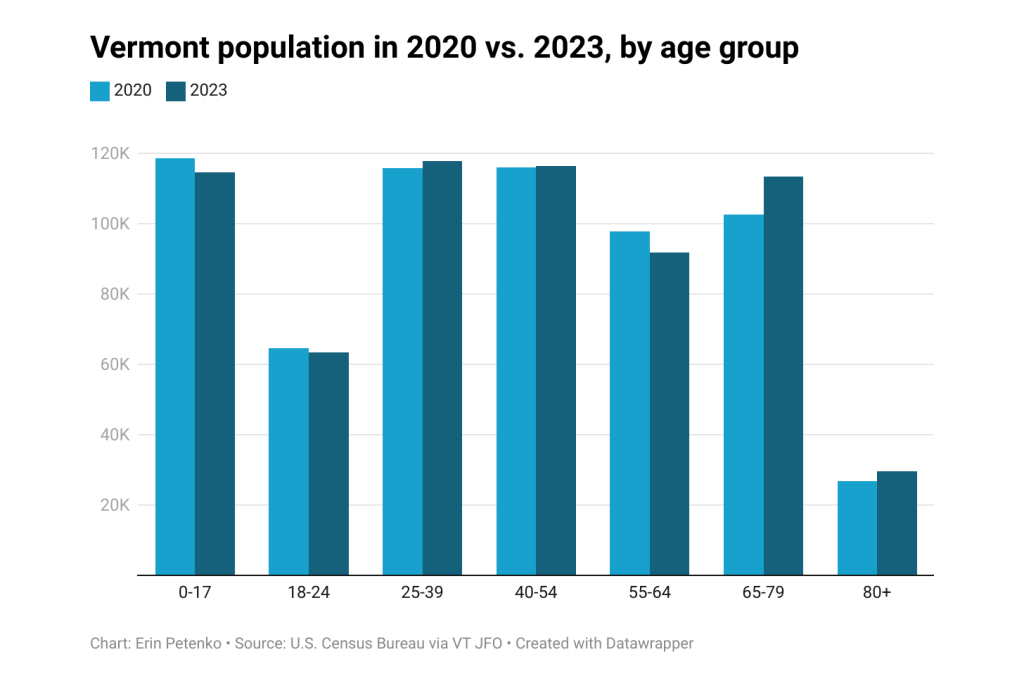Vermont narrowly avoided population decline in 2023 thanks to migration to the state, according to a new report from the state Joint Fiscal Office.
The state had 1,800 more deaths than births between 2022 and 2023, but gained 1,300 people through international migration and 800 people through domestic migration, the report said. The report’s author Joyce Manchester, formerly an economist with the Joint Fiscal Office — which advises the state legislature, based the analysis mainly on U.S. Census Bureau data.
Combined, Vermont gained just 350 people over that year and 4,400 in total since the start of the Covid-19 pandemic, according to the report, barely a blip compared with the overall population of more than 647,000.
Ken Johnson, a demography researcher from the University of New Hampshire, said the findings were in line with long-term trends across northern New England: low fertility levels and rising mortality due to an aging population.
“Part of the reason the mortality levels are so high in these states is because they have so many older adults,” he said. About 22% of the Vermont population is older than 65, compared with the national average of just under 18%.
Vermont’s older population is getting older, too, according to the report. Vermont’s population of 55- to 64-year-olds dropped by 6% between 2020 and 2023, while its population of 65- to 79-year-olds grew by more than 10%.
The report, directed at lawmakers, argues these continuing demographic shifts could have broader implications for the state’s economy and its ability to support older Vermonters, particularly in the health care and social services realm. It would also translate to lower tax revenue per capita, the report said.
“Unless Vermonters ages 65 and older decide to leave Vermont in droves or younger working age people flock to the state in great numbers, Vermont’s share of older people will continue to rise, placing a greater burden on workers to support both young and old,” the report said.
Among the potential policy options that the report suggests exploring are expanding Vermont’s infrastructure, including its housing and broadband access, to attract remote workers and developing a comprehensive approach to providing help to aging Vermonters.
One bright spot amid the bad news for economic growth was an uptick in Vermonters ages 25 to 54. Johnson said that could be connected to Vermont’s pandemic-era migration. While the report doesn’t give specifics on who, specifically, moved to Vermont, anecdotally Johnson said he has heard of working parents moving out of urban areas like Boston to get more space and cheaper housing.
“As they change from one stage of the life cycle to another, their preferences in what they want will change,” he said.
Johnson cautioned that some of the data could be susceptible to error due to low population counts and skewed sampling. College-aged students, for example, saw a slight decline between 2020 and 2023 — but that could simply be due to annual fluctuations in college enrollment.
He noted that inward migration has a long history of influencing Vermont’s population dynamics, based on an analysis of migration data he collaborated on earlier this year.
Vermont lost residents to migration in the 1950s and 1960s but reported an influx of newcomers in the 1970s as Baby Boomers sought out rural areas as part of the “back-to-the-land” movement. That trend continued into the 1980s and 1990s, he said.
“A lot of those people who came then are still there. They’re just older now. So that’s fueling that older population,” he said.
Read the story on VTDigger here: Vermont’s population ticked upward in 2023 — but only slightly.

